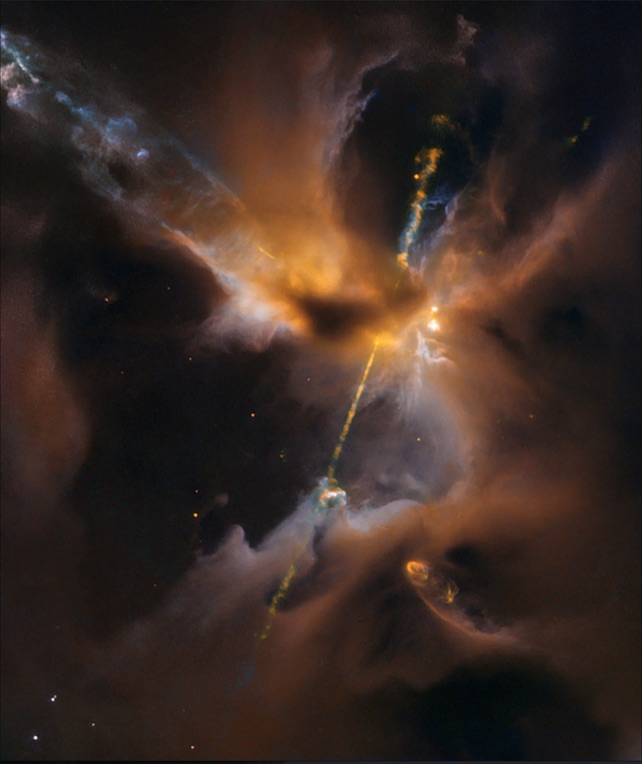While details are understandably scant today, life on Earth is thought to have arisen about 4 billion years ago from a fateful mixture of organic compounds known as the primordial soup.
How and where the components of this initial biological input were created is still an area of debate, given the timeline and surface conditions on the cold young Earth.
Basic substances such as amino acids, fats and sugars can form in the depths of space, recent research has shown, and have been discovered before. Delivered to Earth early Through meteorites and comets.
According to a new study by a team from Germany and France, this scenario is not only plausible, it offers the most likely explanation for how Earth acquired certain building blocks of life, some of which could have formed more efficiently in interstellar space.
The study focuses specifically on the formation of peptides, or short chains consisting of between 2 and 50 amino acids linked by chemical bonds called peptide bonds.
Peptides are the key to life on Earth. Composed of unique sequences of amino acids, they serve diverse functions such as catalyzing a range of biological processes. The researchers suggest that ancient peptides may also have played a role in forming the primitive precursors of cell membranes.
The researchers add that although peptides are clearly important in enabling life on Earth, the young planet may not have provided a great environment for their formation.
They explain that water can have a confounding effect on the formation of peptides from chemical components, and thus may have hindered this part of abiogenesis, or the emergence of life from non-living materials.
There is a surprisingly friendlier place for peptide formation: the interstellar medium, a term that refers to the scattered matter and radiation that occupies the vast swaths of space between stellar systems.
Led by Serge Krasnokotsky, an astrophysicist at the Max Planck Institute for Astronomy in Germany, the study authors simulated conditions found in the interstellar medium, allowing them to test in the laboratory some basic details about how our planet might end up with peptides.

They confirmed, for example, that peptide synthesis depends on three chemical components – carbon, carbon monoxide, and ammonia – the presence of which can lead to the formation of amino acid-like aminoketin molecules in low-density interstellar dust clouds.
As this type of molecular cloud condenses, the dust particles in it begin to coagulate, the researchers note, and the aminoketine molecules can assemble into chains — that is, peptides.
The ongoing coagulation of dust particles in interstellar space can help transform a thin molecular cloud into a denser protoplanetary disk, a ring of debris around a star that eventually condenses to form planets, moons and other celestial bodies.
Within these circumstellar disks, comets or asteroids that are a large distance from their star are “the most interesting objects for peptide formation,” the researchers say. He writes.
When such a body approaches the star and heats up, the evaporation of its internal molecules is generally suppressed, and only molecules in the thin surface layer can evaporate freely.
Once the temperature of an object rises to 176 K, the ammonia in its molecular ice combines with water to form a mixture that has a melting point lower than that of its components. Largely unable to evaporate, the liquid contents found deep within a comet or asteroid could be “well suited” for the formation of aminoketine molecules, the study authors say. He writes.
They point out that solid molecules can move more freely within this liquid state, allowing a high concentration of ammonia molecules to act as catalysts.
Also, because rapid warming can disrupt the formation of peptide bonds, long periods of time during which these orbs undergo temperature changes would likely support peptide synthesis, providing more time for the necessary chemical reactions to occur.
Peptides likely formed in this way as our solar system evolved, the authors suggest, and may have later reached Earth when the young planet was bombarded by meteorites, comets and other potentially peptide-bearing objects.
The arrival of peptides would have given Earth at least one crucial element for life, contributing to the development of proto-membranes, or precursors of the membranes that give cells their structure and surround their contents.
More research will be needed to explore these findings, and continue to fill gaps in our understanding of the origins of life, but the authors say this study adds significant support to the idea that extraterrestrial ingredients helped bring Earth's primordial soup to life.
The study was published in Advancement of science.

“Beer aficionado. Gamer. Alcohol fanatic. Evil food trailblazer. Avid bacon maven.”
